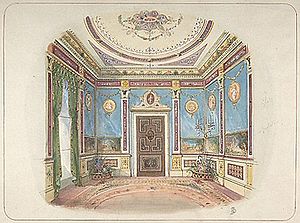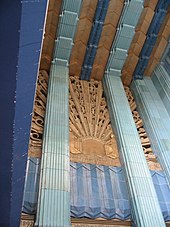Interior design
With a keen eye for detail and a creative flair, an interior designer is someone who plans, researches, coordinates, and manages such enhancement projects.From these, it is possible to discern details about the interior design of different residences throughout the different Egyptian dynasties, such as changes in ventilation, porticoes, columns, loggias, windows, and doors.[5] It was the Greeks, and later Romans who added co-ordinated, decorative mosaics floors,[6] and templated bath houses, shops, civil offices, Castra (forts) and temple, interiors, in the first millennia BC.With specialised guilds dedicated to producing interior decoration, and formulaic furniture, in buildings constructed to forms defined by Roman architects, such as Vitruvius: De architectura, libri decem (The Ten Books on Architecture).In the mid-to-late 19th century, interior design services expanded greatly, as the middle class in industrial countries grew in size and prosperity and began to desire the domestic trappings of wealth to cement their new status.Large furniture firms began to branch out into general interior design and management, offering full house furnishings in a variety of styles.Firms began to publish and circulate catalogs with prints for different lavish styles to attract the attention of expanding middle classes.[9] As department stores increased in number and size, retail spaces within shops were furnished in different styles as examples for customers.He chose a controversial palette of red, yellow, and blue for the interior ironwork and, despite initial negative publicity in the newspapers, was eventually unveiled by Queen Victoria to much critical acclaim.By the turn of the 20th century, amateur advisors and publications were increasingly challenging the monopoly that the large retail companies had on interior design.English feminist author Mary Haweis wrote a series of widely read essays in the 1880s in which she derided the eagerness with which aspiring middle-class people furnished their houses according to the rigid models offered to them by the retailers.In 1876, their work – Suggestions for House Decoration in Painting, Woodwork and Furniture – spread their ideas on artistic interior design to a wide middle-class audience.By 1900, the situation was described by The Illustrated Carpenter and Builder:[18]Until recently when a man wanted to furnish he would visit all the dealers and select piece by piece of furniture ....Today he sends for a dealer in art furnishings and fittings who surveys all the rooms in the house and he brings his artistic mind to bear on the subject.In America, Candace Wheeler was one of the first woman interior designers and helped encourage a new style of American design.She was instrumental in the development of art courses for women in a number of major American cities and was considered a national authority on home design.An important influence on the new profession was The Decoration of Houses, a manual of interior design written by Edith Wharton with architect Ogden Codman in 1897 in America.Her designs were light, with fresh colors and delicate Chinoiserie furnishings, as opposed to the Victorian preference of heavy, red drapes and upholstery, dark wood and intensely patterned wallpapers.[24] Born during the Victorian Era, a time characterized by dark colors and small spaces, she instead designed rooms filled with light and furnished in multiple shades of white and mirrored screens.Interior design is the art and science of understanding people's behavior to create functional spaces, that are aesthetically pleasing, within a building.They go beyond the selection of color palettes and furnishings and apply their knowledge to the development of construction documents, occupancy loads, healthcare regulations and sustainable design principles, as well as the management and coordination of professional services including mechanical, electrical, plumbing, and life safety—all to ensure that people can live, learn or work in an innocuous environment that is also aesthetically pleasing.In some cases, licensed professionals review the work and sign it before submitting the design for approval by clients or construction permitting.The innovative combinations of these materials created contrasts that were very popular at the time – for example the mixing together of highly polished wood and black lacquer with satin and furs.[35][39] Serge Chermayeff, a Russian-born British designer made extensive use of cool metallic colors and luxurious surfaces in his room schemes.This artwork is based on a geometry of straight lines and suggests the patterns common to textile weaving, with solid bands of different colors."[45] "Courtyards and upper pillared porticoes are principal features of the best Nadjdi architecture, in addition to the fine incised plaster wood (jiss) and painted window shutters, which decorate the reception rooms.However, the Najd fretwork seems very different from that seen in the Eastern Province and Oman, which are linked to Indian traditions, and rather resembles the motifs and patterns found in ancient Mesopotamia.In the United Kingdom, popular interior design and decorating programs include 60 Minute Makeover (ITV), Changing Rooms (BBC), and Selling Houses (Channel 4).Another show on the Style Network, hosted by Niecy Nash, is Clean House where they re-do messy homes into themed rooms that the clients would like.Famous interior designers whose work is featured on these programs include Bunny Williams, Barbara Barry, and Kathy Ireland, among others.Some examples include Sister Parish, Robert Denning and Vincent Fourcade, Kerry Joyce, Kelly Wearstler, Stéphane Boudin, Georges Geffroy, Emilio Terry, Carlos de Beistegui, Nina Petronzio, Lorenzo Mongiardino, Mary Jean Thompson and David Nightingale Hicks.Notable interior designers in the world today include Scott Salvator, Troy Adams, Jonathan Adler, Michael S. Smith, Martin Brudnizki, Mary Douglas Drysdale, Kelly Hoppen, Kelly Wearstler, Nina Campbell, David Collins, Nate Berkus, Sandra Espinet, Jo Hamilton and Nicky Haslam.













Interior design (disambiguation)the English-speaking worldart décogrand concourse30th Street StationPhiladelphiaHotel Bristol, WarsawBalliol CollegesciencebuildingcreativeVlkolínecSlovakiaarchitectureVishwakarmaShekhawati region of Rajashtandisplay wall art paintingstricliniumklinaiNess of BrodgarSkara Braemosaicsbath housesCastra (forts)templeVitruviusDe architectura, libri decemupholsterermiddle classindustrialfurnitureamateurJames Shoolbred Companyofficeshotelspublic buildingscatalogsexhibitionsWaring & GillowJames ShoolbredMintonsCivil WarHerter Brothersupholsterywarehouseinterior decoratorsOwen JonesJoseph PaxtonCrystal PalaceGreat ExhibitionpaletteQueen VictoriaThe Grammar of OrnamentAlfred MorrisonIsmail PashaKhediveLondon DirectoryPost OfficeThomas Edward CollcuttEdward William GodwinCharles BarryGottfried SemperGeorge Edmund StreetJohn Dibblee CracefeministMary HaweisRhoda GarrettAgnes GarrettWilliam MorrisCandace Wheelerinterior designersThe Decoration of HousesEdith WhartonOgden Codmaninterior decorationVictorian bric-a-bracElsie de WolfeChinoiserieColony ClubMadison AvenueSyrie MaughamNew York CityChicagoVictorian EraWorld War IIarchitectsindustrial designersengineersChartered Society of Designersfunctional designacousticslightingADA requirementstheir psychological effectsmeaning of each color in different locations and situationsred-coloredhome accessoriesUnexpected Red TheoryRio de Janeiroexhibit designtablescapescenic designproduction designgerontological designCornell UniversityUniversity of FloridaPaolo MontiInterior design educationTerracottaArt Decosunburst designEastern Columbia BuildingArt Nouveauchromestainless steelmirrorsaluminiumlacquerinlaid woodsharkskinFirst World WarSerge ChermayeffmodernistFrank Lloyd WrightFallingwaternagash painting